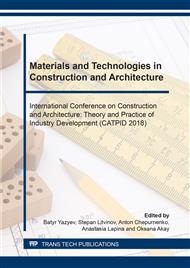[1]
V.D. Glukhovsky, Alkaline and alkaline-alkaline-earth hydraulic binders and concretes, Kiev, Vishcha shkola, (1979).
Google Scholar
[2]
V.D. Glukhovsky, V.A. Pakhomov, Slag-alkaline cements and concretes, Kiev, Budivelnik. (1978).
Google Scholar
[3]
P.V. Krivenko, K.K. Pushkarev, Durability of slag-alkaline concrete, Kiev, Budivelnik. (1993).
Google Scholar
[4]
J. Davidovitz, Geopolymer. Chemistry and applications, Saint-Quentin: Institute Geopolymer, (2008).
Google Scholar
[5]
P. Duxson, A. Fernandez, J. L. Provis, Geopolymer technology: The current state of the art, J. Мater. Sci. 42 (2007) 2917-2933.
Google Scholar
[6]
S.-A. Yu. Murtazaev, M.Sh. Salamanova, M.S. Saidumov, Influence of active surface centers on the reactivity of mineral additives, Contemporary Science and Innovations. 18 (2017) 168-175.
Google Scholar
[7]
S.-A.Yu. Murtazaev, M.Sh. Salamanova, R.G. Bisultanov, T. S.-A. Murtazaeva, High-quality modified concrete with the use of a binder based on a reactive mineral component, Building Materials. 8 (2016) 74-80.
Google Scholar
[8]
S.-A.Yu. Murtazaev, M.Sh. Salamanova, A.Kh. Alaskhanov, Binder with alkaline activation as an alternative to Portland cement, in: International Scientific and Practical Conference Innovations in Construction-2017,, Bryansk, 2017, pp.92-97.
Google Scholar
[9]
V. V. Strokova, I. V. Zhernovsky, A. V. Maksakov, Express method for determining the activity of silica raw materials for the preparation of a granular nanostructured aggregate, Building Materials. 1 (2013) 38-39.
Google Scholar


